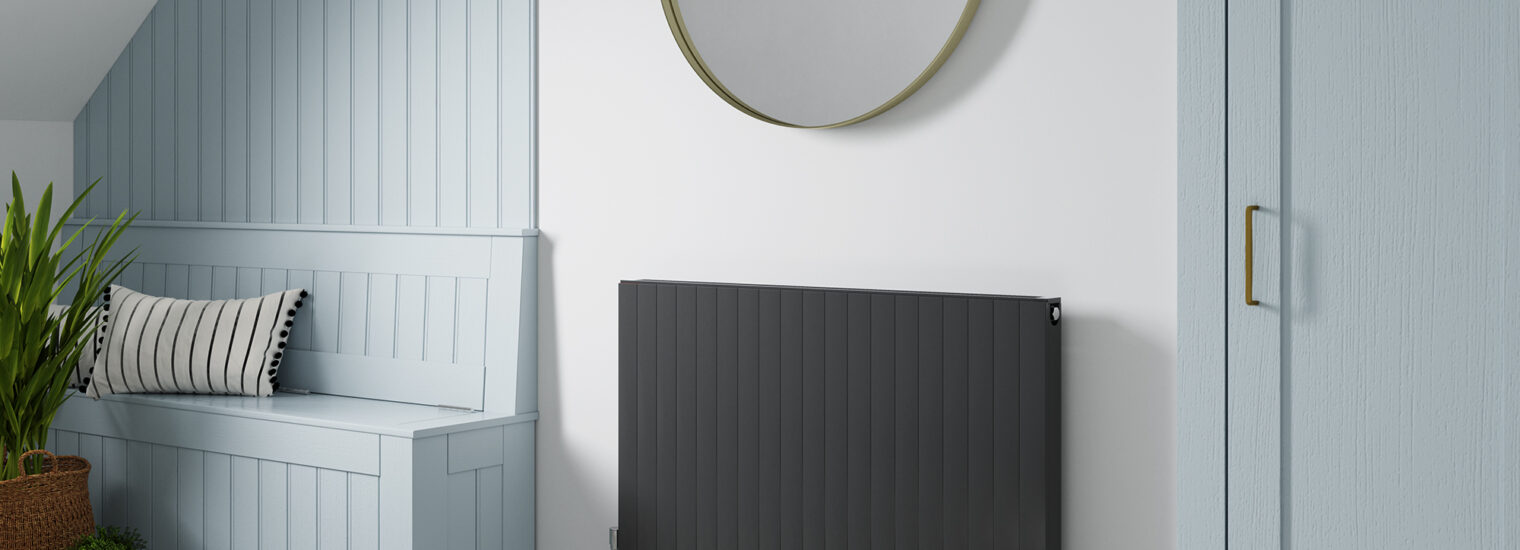A key aspect of improving your home’s energy efficiency is correctly calculating how much energy you need to generate to keep your home warm. Consequently, this avoids under or overheating. Delta T is a vital part of helping you calculate this.
Delta T (also recognised as Δt) will help you choose the right size and type of radiators the first time around.
This article aims to provide an overview of what Delta T is, what it means for your home heating requirements and the importance of its consideration in choosing radiators.
What is Delta T?
Before going any further, it’s essential to understand what exactly Delta T means. In short, Delta T refers to the difference in average temperature between the water circulating throughout your central heating system and the room temperature.
For example, if the room temperature is 20C and the average water temperature inside the radiators is 70C, the Delta T value is calculated as 70C – 20C = 50C (delta t50).
Most radiators show radiator delta T as Δt50° (delta t50). Because delta t50 is the current European standard for modern boilers and radiator systems. Older boilers often have delta t60. Delta T is used to state a room’s heating requirement and radiator output.
When replacing or assessing radiators in your home, you must use the correct Delta T. You will notice that some radiators have different outputs at different water temperatures due to the home heating system <link to another blog> you are using.
The main thing to remember is the following equation:
Average Temperature of Radiator Water – Average Desired Room Temperature = Delta T
The Importance of Understanding Delta T
Your home heating system is correct for optimal warmth and efficiency. Understanding and considering the Delta T in your radiator purchases will help avoid your radiators being the incorrect size for the home.
Delta T is also helpful for you to understand your room’s heating requirements based on your existing system. For example, if your current home heating system requires delta t50 (Δt50) and you choose radiators based on delta t60 (Δt60°), then the heat output of your radiators will be too low.
When comparing radiator outputs and prices, check which Delta T ΔT is being quoted. Please don’t hesitate to get in touch with any questions.
The Optimal Radiator Delta T Value – Delta t50 (Δt50) vs Delta t60 (Δt60°):
A radiator’s output is usually expressed in watts, and the wattage of your radiator is based on the system’s likely operating temperature. The output will be Delta 60 (Δt60) or Delta 50 (Δt50).
Delta 50 is the UK standard for all domestic gas boilers. It allows professionals, end-users and consumers like yourself to make fair and reasonable comparisons and judgements when buying radiators — for example, comparing hydronic radiators and towel rail radiators output across a mix of product types.
If you’re looking into newer, more renewable heating systems, you can also purchase radiators with a lower-level output. For example, Delta t30 and Delta t40 work well for lower water temperature systems.
Why Should You Consider Low-Temperature Heating, i.e. Low Delta T Radiators?
As our homes become increasingly better insulated, people turn to low-temperature heating systems with low-level delta T radiators. These newer, more renewable heating systems utilise Delta t30 and Delta t40 outputs to create an eco-friendlier unit.
Low-temperature heating boasts the ability to heat your home more evenly, at a more constant pace. Plus, it’s gentle on the purse strings as well! Whereas traditional heating systems will use a supply temperature between 75°C and 85°C, low-temperature heating can be anywhere between 35°C and 55°C.
What is the Benefit of Low-Temperature Heating?
The following are a handful of benefits of choosing low-temperature heating:
More Cost-Effective: Providing a well-insulated home using low-temperature heating will reduce energy consumption.
Less Cold Corners: Your whole room will heat more evenly with a low-temperature heating system.
Practical: Using low-temperature heating means you won’t have to turn down the thermostat at night. This means the only time you will need to adjust the thermostat is when you are away for a longer length of time.
Cleaner Air: Using a low-temperature heating system will produce less airborne dust. This is good news for anyone with allergies as you will be avoiding any scorch marks created by dust particles. Consequently, this will reduce any irritation to sensitive airways.
If you like the sound of a low-temperature heating system, discuss it as an option with your plumber. As mentioned above, plumbing systems using modern condensing boilers typically work at Delta t50. Therefore, you will need to specify a lower Delta T if you want to create an eco-friendlier heating system.
In conclusion, we hope this article has provided insight into the importance of Delta T for choosing radiators for your home and its value for creating efficient heating. You can also use our BTU heat loss calculator to understand the different factors you’ll need to consider for each room before buying new radiators. This can be helpful to discover the size of radiator you’ll need to provide the best heating performance per room.
If you have any questions, please don’t hesitate to contact our team at Stelrad.

